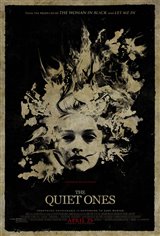The Quiet Ones is a horror film about a professor who uses unorthodox and controversial methods to teach his students. Professor Coupland believes that humans can harness negative energy to create supernatural forces, and he collaborates with a group of students to test this theory and create a poltergeist. The group conducts a series of experiments on a girl, and what results is far beyond their wildest imagination.
This film is loosely based on an actual experiment that took place in Toronto in 1972. Under the direction of mathematician and poltergeist expert Dr. Alan Robert George Owen, a group of parapsychologists conducted what is known as "The Philip Experiment." The group consisted of eight people from the Toronto Society for Psychical Research, and before the start of the experiment, none of them demonstrated they had any psychic capabilities.
The group wanted to test the theory that humans can use their minds to create spirits, and so the first logical step in their experiment was to create a life story and make it as real as possible. The group concocted a detailed account of the life of Philip Aylesford, complete with a birth date and location, marriage and love affair and even his own death in 1654. He was born an English nobleman, and his marriage to his cold wife Dorothea was strained by an affair he had with a gypsy named Margo. Dorothea eventually found out about the affair and accused Margo of witchcraft, and she was burned at the stake. Philip spent the rest of his days remorseful, and he died alone on the battlefield. The group went as far as traveling to Philip’s supposed town and taking photographs, as well as sketching drawings of him.
After the story of Philip Aylesford was eloquently put together, the group started holding regular séances in September of 1972, where they would discuss his life and meditate deeply. The group sat around a table and lit candles as they shared stories about his life, hoping that he would reach out to them. It took a year for “Philip” to make an appearance, and at first, those appearances were very brief – he would tap or make small noises to make the group aware of his presence. His presence started to become stronger, and he would reply to questions from the group with a sequence of knocks on the table – one knock was a “yes” and two knocks were a “no.” The group claimed Philip was able to accurately answer questions about historic information from his time period, and the plausible explanation for this was that it came from their own collective unconscious.
The group claimed he eventually manifested physical abilities and managed to move a table and flicker the lights in the room on command, for which they had no scientific explanation. However, they were never able to see a physical manifestation of Philip, which led to many believing that it was all just an elaborate hoax. Other debates suggest that the group’s frequent séance sessions allowed them to actually contact the spirit world, and the supernatural entity they encountered simply latched onto the idea of “Philip” and impersonated him. After these events, Dr. Owen continued to test his theory by conducting similar experiments, and the Philip Experiment would later inspire other experiments as well.
